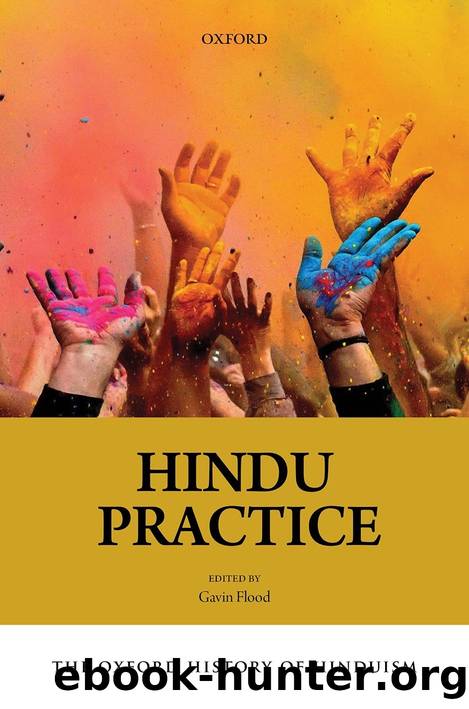The Oxford History of Hinduism by Flood Gavin;

Author:Flood, Gavin; [Flood, Gavin]
Language: eng
Format: epub
Publisher: Oxford University Press USA - OSO
Published: 2020-07-28T00:00:00+00:00
1. Daily Ritual (Nitya-Karma)
Tantric Åaiva religion is a religion of ritual par excellence. After initiation the Åaiva SiddhÄntin was required to undergo a daily regime of ritual, worshipping Åiva at the junctures of the day in the belief that this ritual would help to erase the effects of past action and that, at death, with Åivaâs grace, the adept would attain liberation. As in Jainism, rather than knowledge it is action that creates the conditions for liberation. This was a religion of the householder who maintained general adherence to Vedic Brahmanical values (varnÌ£ÄÅrama-dharma) but believed his tantric revelation went far beyond the Veda. The ritual system of the Åaiva SiddhÄnta became normative and spread throughout the sub-continent from Kashmir to the South where it absorbed Tamil devotionalism.3 Technically there are twenty-eight Åaiva SiddhÄnta Tantras along with other texts, although there are actually more, particularly ritual manuals or paddhatis that were used as the practical basis for ritual procedure. These paddhatis were distillations of ritual from the Tantras, containing details of actions to be performed along with the mantras to be uttered and the hand gestures (mudrÄ) to be used. The most famous is the paddhati of SomaÅambhu, carefully edited and translated by Hélène Brunner, and also the paddhati of ĪÅÄnaÅivagurudeva composed in Kerala. Both of these texts are probably eleventh century, although the latter quotes the former and so is later. The ĪÅÄnaÅivagurudeva-paddhati is still used by some Nambudri Brahman families of the Taranallur clan in the Alwaye region of Kerala (Unni 1988) and is distinctive in the Åaiva SiddhÄnta corpus for containing chapters on possession and exorcism.
The daily ritual life of the Åaiva SiddhÄntin involved making vegetarian offerings to the Åiva linÍga, the icon of Åiva, in a standard way, first having identified himself with his God, for one of the distinctive features of tantric worship is that only a god can worship a god. The divinization of the person is therefore an important part of the ritual process. In the SomaÅambhupaddhati this process takes the form of purificatory bathing (snÄna), the purification of the elements within the body (the bhÅ«taÅuddhi), the divinization of the body through imposing mantras upon it (nyÄsa), and the internal worship of the deity within the imagination (antara-/mÄnasa-yÄga), followed by external worship (bahya-yÄga) to an icon of the god (Sanderson 1995: 27â9). Following external worship, a Vedic homa rite was added on to the tantric worship. In this process the vertical structure of the cosmos is mapped onto the vertical structure of the body. The Åaiva SiddhÄnta codified this cosmology in the âsix waysâ (sÌ£aá¸adhvan) that divided the hierarchy into three paths of sound and three of space, each of which in itself is a complete hierarchical structure.4 This is pervasive in tantric ritual and might even be considered to be a distinctive feature of it, although there are Vedic precedents before the emergence of Tantra (Einoo 2005: 7â49).
A particularly interesting text from the Åaiva Mantra MÄrga is the Netra-tantra, the âeyeâ tantra, also called the âLord of Immortalityâ (AmrÌ£teÅvara-tantra).
Download
This site does not store any files on its server. We only index and link to content provided by other sites. Please contact the content providers to delete copyright contents if any and email us, we'll remove relevant links or contents immediately.
The Lost Art of Listening by Michael P. Nichols(7179)
Why I Am Not A Calvinist by Dr. Peter S. Ruckman(4052)
The Rosicrucians by Christopher McIntosh(3378)
Wicca: a guide for the solitary practitioner by Scott Cunningham(3048)
Signature in the Cell: DNA and the Evidence for Intelligent Design by Stephen C. Meyer(2882)
Real Sex by Lauren F. Winner(2876)
The Holy Spirit by Billy Graham(2784)
To Light a Sacred Flame by Silver RavenWolf(2684)
The End of Faith by Sam Harris(2637)
The Gnostic Gospels by Pagels Elaine(2407)
Waking Up by Sam Harris(2337)
Nine Parts of Desire by Geraldine Brooks(2285)
Jesus by Paul Johnson(2232)
Devil, The by Almond Philip C(2213)
The God delusion by Richard Dawkins(2195)
Heavens on Earth by Michael Shermer(2194)
Kundalini by Gopi Krishna(2094)
Chosen by God by R. C. Sproul(2058)
The Nature of Consciousness by Rupert Spira(1983)
